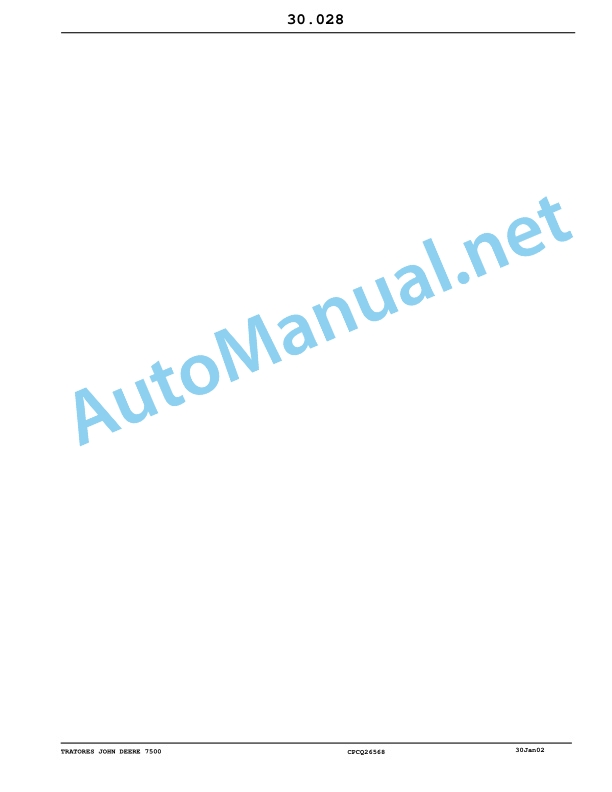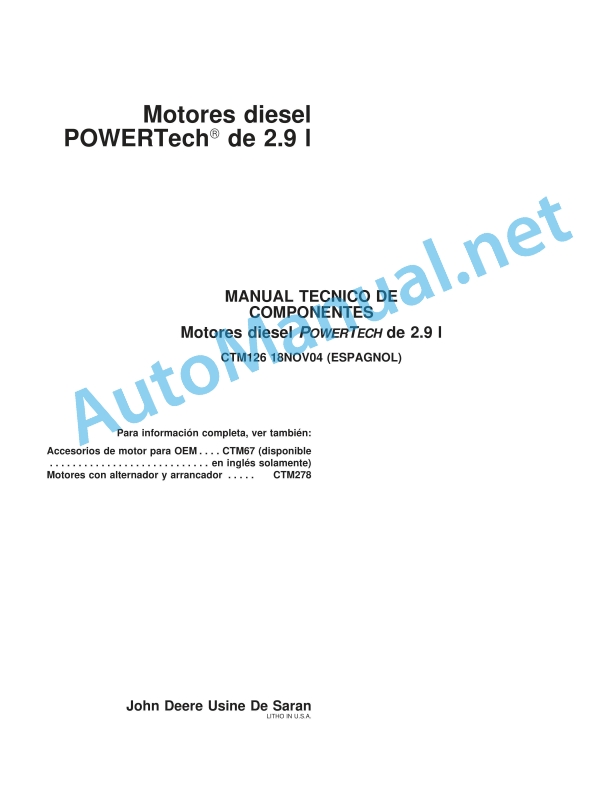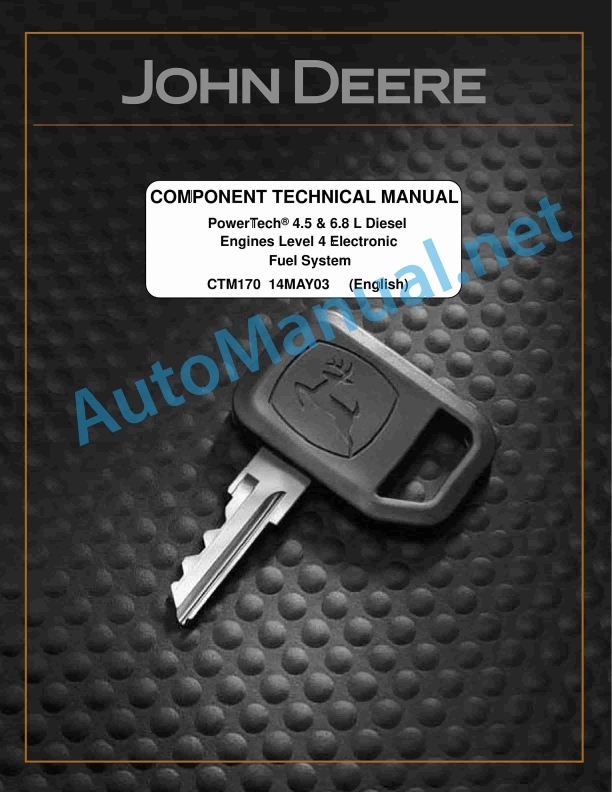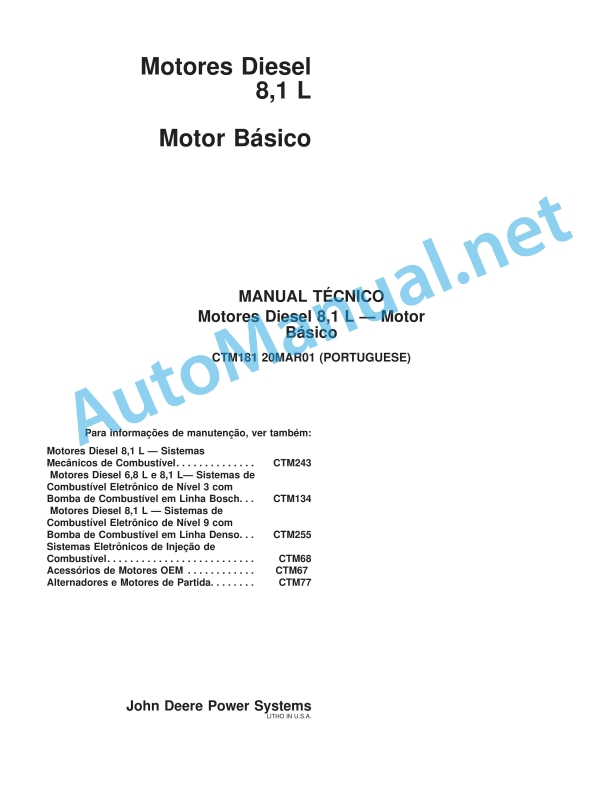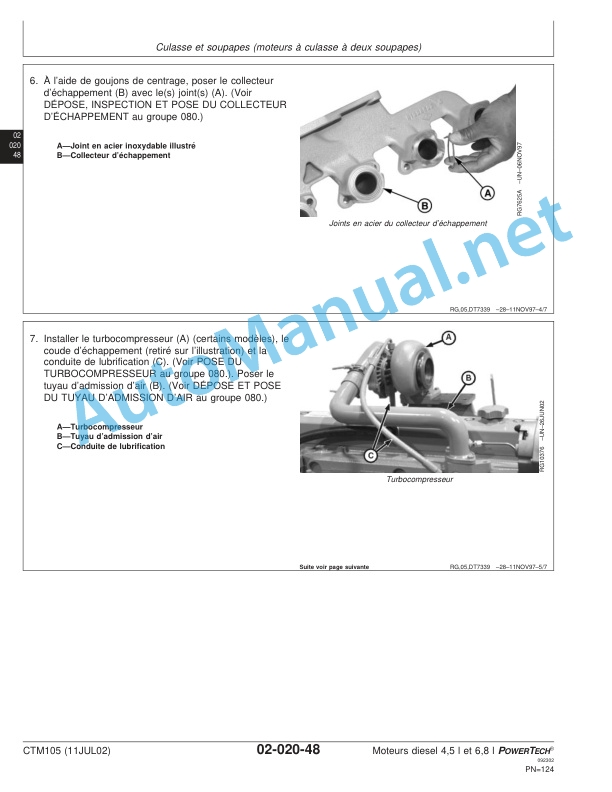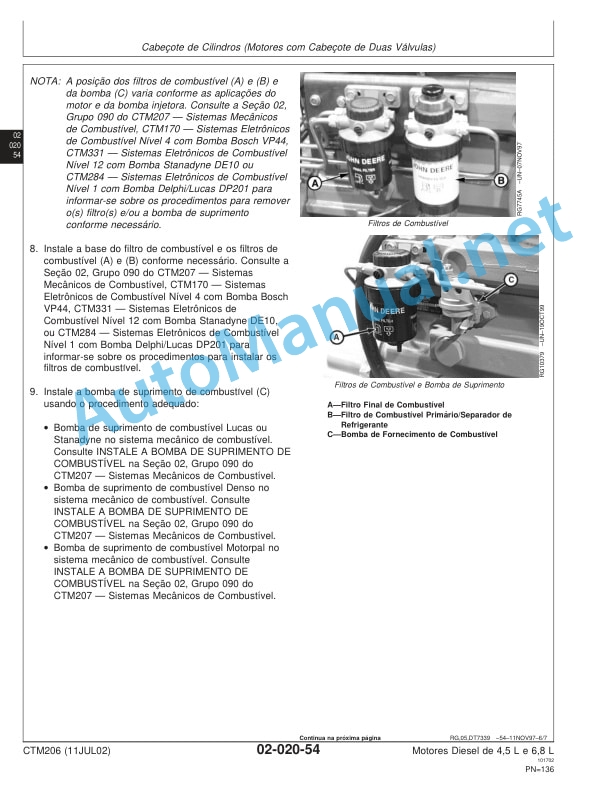Claas Rb 130, 140, 160 Tractors Service Information EN
$50.00
- Model: Rb 130, 140, 160 Tractors
- Type Of Manual: Service Information
- Language: EN
- Format: PDF(s)
- Size: 8.4 MB
File List:
Use and Maintenance RB 130, 140, 160 en.pdf
Use and Maintenance RB 130, 140, 160 en.pdf:
For your safety
Warning triangle
Appropriate use
Chapter symbols
NE_BASSO_1007_TDM04A.pdf
SOMMAIRE
A – IDENTIFICATION – CERTIFICATION – SAFETY
IDENTIFICATION A. 2
SAFETY A. 3
Safety stickers with warning pictograms A. 13
B – Roll bar
Controls and driving position B. 2
Indicators and warning lights B. 3
ALARMS B. 4
Digital display (option) B. 5
Controls and accessories B. 7
DRIVER’S SEAT B. 8
Folding roll bar B. 9
C – Electrical system
CHARACTERISTICS C. 2
LIGHTING – INDICATORS C. 4
CONTROLS C. 5
FUSES C. 7
D – ENGINE
CHARACTERISTICS D. 2
Operations to be carried out before starting up D. 3
OPERATION D. 5
Bleeding air from the injection system D. 8
E – Transmission
Speed calculation table E. 2
Forward speed table E. 3
Drive clutch E. 4
GEAR BOX E. 5
Range selection E. 7
differential E. 7
Brake system E. 8
PTO E. 9
Stationary working E. 12
Towing the tractor E. 12
F – FRONT AXLE
CHARACTERISTICS F. 2
Front axle engagement F. 3
G – Hydraulics – rear linkage and hitch
CHARACTERISTICS G. 2
Rear lift G. 3
REAR HITCH ADJUSTMENT INSTRUCTIONS G. 5
AUXILIARY SPOOL VALVES G. 8
J – WHEELS AND TYRES
GENERAL J. 2
TYRE PRESSURES J. 2
Tyres and tracks J. 4
SETTING THE TRACK J. 7
STEERING STOPS J. 8
K – Dimensions, weights, capacities and ballast
Dimensions roll bar version K. 2
Weight K. 3
Ballast K. 3
Capacities K. 5
L – MAINTENANCE
GENERAL L. 2
M – Operations that are mandatory under the guarantee
OPERATIONS MANDATORY UNDER THE TERMS OF THE CONTRACTUAL GUARANTEE M. 2
CHAP-A-04A.pdf
A – IDENTIFICATION – CERTIFICATION – SAFETY
IDENTIFICATION
A – Tractor type.
B – Certification N°.
C – Tractor identification number.
D – Maximum allowable gross eght depending on tyre fit (in kg).
E – Front axle weight.
F – Rear axle weight.
G – Maximum unbraked trailer weight (in kg).
H – Maximum trailer weight – mechanical brake (in kg).
I – Maximum trailer weight – inertia brake (in kg).
J – Maximum trailer weight – servo brake (in kg).
K – Smoke absorption coefficient.
Certification
FOREWORD
PRECAUTIONS BEFORE STARTING
CONDITION OF THE TRACTOR
ADJUSTMENT OR MAINTENANCE – REPAIRS
AXLE STANDS
Hydraulic systems
Electrical system
Re-fuelling
ROAD USE – USE FOR TRANSPORT
OPERATION
GENERAL RULE
WHEEL TRACK
ATTACHING IMPLEMENTS
STATIONARY WORK
USE OF TOOLS DRIVEN BY THE PTO
TOXIC PRODUCTS
IMPORTANT
Air conditioning
RECOMMENDATIONS:
IMPORTANT
SAFETY CABS
ENVIRONMENTAL SAFETY
Safety stickers with warning pictograms
CHAP-B-04A.pdf
B – Roll bar
Controls and driving position
1 – PTO clutch lever.
2 – Control for headlights, indicators and horn.
3 – Clutch pedal.
4 – Steering wheel height adjustment lever.
5 – Instrument panel.
6 – Manual accelerator lever.
7 – Reverse lever.
8 – Brake pedals.
9 – Accelerator pedal.
10 – Gear lever.
11 – Range lever.
12 – Position control lever.
13 – Force control lever.
14 – Auxiliary distributor levers.
15 – Power takeoff selector.
16 – Front axle engagement switch.
17 – Hazard warning light switch.
18 – Working lights actuation contact.
Indicators and warning lights
1 – Tachometer.
2 – Engine cylinder head temperature indicator.
3 – Fuel gauge.
4 – Fuel low level warning light.
5 – Preheat indicator.
6 – Battery charge warning light.
7 – Blocked dry type air filter warning light.
8 – Oil pressure warning light.
9 – Front axle engagement indicator light.
10 – Tractor direction indicators repeater.
11 – Hand brake warning light.
12 – Power takeoff running indicator.
13 – Spare position.
14 – Position light indicator.
15 – 1st trailer direction indicators repeater.
16 – Headlight main beam warning.
17 – Digital display (option).
18 – Hour counter.
19 – Hydraulic doubler engaged lamp.
RED PRIMARY ALARM LIGHTS
Battery charge warning light
Engine oil pressure warning light
Hand brake warning light
ORANGE CAUTION LIGHTS
Blocked dry type air filter warning light
When this warning light comes on, it is time to change the main filter.
Fuel low level warning light
Digital display (option)
Setting the digital display
Display setting procedure
1 – Switch the ignition off, press the program button (2), then switch the ignition on.
2 – Release the button (2). The display indicates ‘SET’.
3 – Press the butotn (2) again until the new parameter required appears in the display.
4 – Release the button. The display indicates ‘OFF’.
5 – Return the ignition key to the 0 position.
Setting table
Controls and accessories
Adjustable steering column
Rear view mirrors
Adjustment
DRIVER’S SEAT
Waterproof seat
1 – Longitudinal adjustment.
2 – Suspension adjustment.
3 – User weight adjustment.
Folding roll bar
CHAP-C-04A.pdf
C – Electrical system
CHARACTERISTICS
Battery : 12 V – 100 Ah
Alternator : 14 V – 55 A
TOWING SOCKET
Trailer/tool lighting outlet (A)
1 – Left direction indicators.
2 – Available.
3 – Earth.
4 – Right direction indicators.
5 – RH sidelights + Number plate light.
6 – Brake light.
7 – LH sidelights.
Electric cabinet supply socket (B)
Lighting – indicators
AT THE FRONT
1 – Headlights (dipped/main beam).
2 – Side indicator repeaters :
3 – Working lights.
4 – Number plate light
5 – Side indicator repeaters :
6 – Trailer/implement light socket.
7 – Reflectors.
CONTROLS
Direction indicators
Horn (III)
Headlights
To flash headlights
Rotating beacon switch
Hazard warning lights
Working headlight
Key operated ignition
Position of the ignition
Fuse box (2) : Mechanical doubler version only
Hydraulic doubler version only
CHAP-D-04A.pdf
D – ENGINE
CHARACTERISTICS
Operations before start
Starting and stopping the engine
STARTING THE ENGINE
Starting in normal conditions
In cold weather
STOPPING THE ENGINE
OPERATION
RUNNING-IN
Recommendations:
1 – Avoid operating lightly loaded or for long periods at idle. Lack of load during the first 100 hours can cause glazing of the cylinder liners. This leads to excessive oil consumption and loss of power.
2 – Avoid overloading the engine: The engine suffers overload when too high a gear ratio is used and engine speed drops to about…
3 – Pay particular attention to fluid levels (oil and coolant) as well as engine temperature.
Operating temperature
OPERATING RPM
Maximum off-load rpm
Rated speed
The rated engine speed is reached at maximum power.
Maximum speed on the road
Specific consumption
Operating at intermediate power
Full power operation
Quality requirement
Filling the tank
1 – Clean the area around the fuel drum cap.
2 – Remove the cap and put it in a clean, dry place.
3 – After refuelling, replace and tighten the filler cap.
Handling the fuel
Bleeding air from the injection system
CHAP-E-04A.pdf
E – Transmission
Speed calculation table
Engine speed 2 200 rpm
Low range. Field range. Road range.
Tables of forward speeds
Drive clutch
GEAR BOX
Mechanical drive reverser
I Forward.
II Reverse.
Mechanical range doubler
This lever can be operated when the tractor in motion. This involves lifting off the accelerator pedal, declutching, placing the lever in the chosen position, progressively engaging the clutch and accelerating.
Electro-hydraulic range doubler
Range selection
Differential
Brake system
Brake pedal (1)
Handbrake
To apply the hand brake:
To release:
Trailer brake
Hydraulic braking
Rear PTO with mechanical clutch
De-clutching
Selection of PTO speeds
Hitching-up and towing PTO attachments
Important
Stationary working
Towing the tractor
CHAP-F-04A.pdf
F – FRONT AXLE
Characteristics
Front axle engagement
Operation
CHAP-G-04A.pdf
G – Hydraulics – rear linkage and hitch
Characteristics
Hydraulic pump
Fluid capacities
Hydraulic trailer brake valve (depending on equipment fit)
Hydraulic lift
Rear lift
Position control
Operation
Force control
Operation
Adjustment
Implement handling at end of row
Floating linkage
Instructions for adjusting the rear hitch
Influence of hitch geometry on lifting capacity
A – Top link (upper link attachment point with respect to the centre line of the wheels and the length of the link). High position: 221 mm. Middle position: 281 mm. Low position: 346 mm.
B – Lower links (lower link attachment points).
C – Lifting rods (length of lifting rods).
Maximum mechanical advantage
Minimum mechanical advantage
Adjusting the lifting rods
Adjusting the stabilisers
Adjustment of lateral stabilisers
Hydraulic adjustment of the lateral stabilisers
Auxiliary spool valves
Control levers and pressure connectors
Operation
Hydraulic couplers
PRESSURE CONNECTORS REAR
PRESSURE CONNECTORS On the side
Single-acting spool valve
Operation
Pressurising
Return to the tank
3-position double-acting spool valve
Operation
4-position double-acting spool valve
Dual acting/single acting conversion
Flow regulator
OPERATION
Free return
Brake valve
Rear hitches
Hitch fork
CHAP-J-04A.pdf
J – WHEELS AND TYRES
REPLACEMENT OF TYRES, USE OF DIFFERENT TYPES OF TYRE
Special case of tractors with four wheel drive
Front/Rear inter-axle ratio
TYRE PRESSURES
Tyre marking
Operating on soft ground (to improve grip)
Operating on hard ground (on the road, towing, etc.)
Rear axle
Tyres and tracks
The front track is the distance at ground level between the centres of the front tyres. The rear track is the distance between the centres of the rear tyres at ground level.
Tyre combinations Available in 4 WD
Tables of front tracks (4 wheel drive tractor)
Tables of rear tracks
SETTING THE TRACK
Front and rear axle
Tracking method
STEERING STOPS
Adjustment
CHAP-K-04A.pdf
K – Dimensions, weights, capacities and ballast
Dimensions roll bar version
(with standard tyres)
When they leave the production line, tractors are ballasted to behave normally in most operating situations. However, depending on working conditions, the ballast can be changed (see ballast table).
Water ballast
On 4WD tractors, a 50% water ballast is only allowed on the front tyres.
Filling the tyres
Capacities
The table below indicates the quantities of lubricant and fluid to be used in each component.
Only use recommended lubricants and fluids.
When topping up, the oil or fluid category must not be changed.
Regular oil changes are essential.
CHAP-L-04A.pdf
L – Maintenance
General cleaning
High-pressure cleaning systems
ROUTINE MAINTENANCE
Touching up paintwork
FAILURES OR MALFUNCTIONS
Decrease in fluid level
Quantity and type of oil
Grease quality
Primary diesel filter: Cleaning – Replace
Engine air filter: Cleaning
Forward clutch clearance: Check
PTO clutch clearance: Check
Timing belt: Check – Replace
Hydraulic /transmission oil level (Gearbox + Rear axle): Check
Engine oil level: Check
Radiator grills: Cleaning
Turbine, radiator, cylinder head and cylinder fins: Cleaning
Front axle swing bearings : Lubrication
Transmission shaft: Lubrication
Front axle king pins: Lubrication
Rear lift: Lubrication
Front axle final drive oil level: Check
Tighten wheel disc and rim nuts: Check
Tyre inflation pressure: Check
Front axle differential sump oil level: Check
Brake pedals – Level of the braking valve (for trailor): Check
Hydraulic circuit/transmission filter cartridge: Replace
Front weight attachment bolts: Check
Engine oil: Replace
Electrolyte level in the battery: Cleaning – Lubrication
Engine oil filter cartridge: Replace
Hydraulic strainer: Replace
Diesel filter cartridge: Replace
Hand brake clearance: Check
Wheel hubs: Lubrication
Front axle differential casing oil: Replace
Front axle final drive oil: Replace
Front axle breather: Replace
Hydraulic/transmission oil: Replace
Rear axle breather: Replace
Starter and alternator
Engine air filter (dry cartridge): Replace
Manifold tightening: Check
Rocker arms and injectors: Check
Injectors
Diesel fuel pre-filter
MAINTENANCE RECORD
Operations to be carried out every 250 h
Operations to be carried out every 500 h
Operations to be carried out every 1 000 h
Operations to be carried out every 2 000 h
CHAP-M-04A.pdf
M – Operations that are mandatory under the guarantee
OPERATIONS MANDATORY UNDER THE TERMS OF THE CONTRACTUAL GUARANTEE
Pre-delivery inspection – Handing over to the customer
a ) Pre-delivery inspection
Your CLAAS agent is responsible for preparing your tractor before delivery:
He must stamp and sign it after checking and confirming the service handbook inspections.
If you wish, he can also install any certified equipment or after-sales options (air-conditioning, front power take-off and linkage, radio, etc.).
b ) Handing over to the customer
Your supplier must provide you with the use and servicing handbook on delivery. He must explain this document and carry out a test, with you, in the field in order to familiarise you with your new tractor, and to answer all your questions.
The Acknowledgement of receipt, Pre-delivery inspection and Delivery to the customer sheets (to be found in the service handbook) must be filled in and signed by the technician responsible for the handover, and signed by the user.
On of the copies of the acknowledgement of receipt remains in the service handbook which is given to the user. The other copies are intended for CLAAS.
MANDATORY ROUTINE MAINTENANCE
HYDRAULIC SYSTEM
HYDROSTATIC STEERING
FRONT DRIVE TRAIN – FRONT AXLE
TRANSMISSION – LINKAGE
WHEELS AND TYRES
ELECTRICAL SYSTEM
Battery:
Instrument panel:
HYDRAULIC SYSTEM
HYDROSTATIC STEERING
FRONT DRIVE TRAIN – FRONT AXLE
TRANSMISSION – LINKAGE
WHEELS AND TYRES
ELECTRICAL SYSTEM
Battery:
Instrument panel:
John Deere Parts Catalog PDF
John Deere Tractors 7500 Parts Catalog CPCQ26568 30 Jan 02 Portuguese
John Deere Repair Technical Manual PDF
John Deere Diesel Engines POWERTECH 2.9 L Component Technical Manual CTM126 Spanish
John Deere Repair Technical Manual PDF
John Deere Repair Technical Manual PDF
John Deere Repair Technical Manual PDF
John Deere Repair Technical Manual PDF
John Deere Repair Technical Manual PDF
John Deere DF Series 150 and 250 Transmissions (ANALOG) Component Technical Manual CTM147 05JUN98
John Deere Repair Technical Manual PDF
John Deere Repair Technical Manual PDF
John Deere PowerTech M 10.5 L and 12.5 L Diesel Engines COMPONENT TECHNICAL MANUAL CTM100 10MAY11
John Deere Repair Technical Manual PDF




